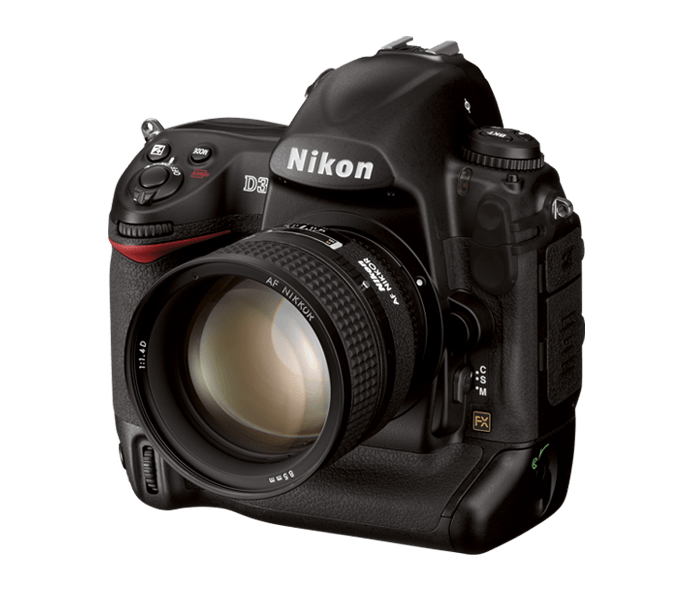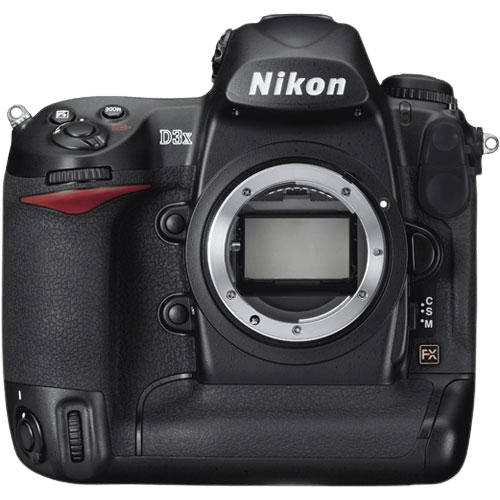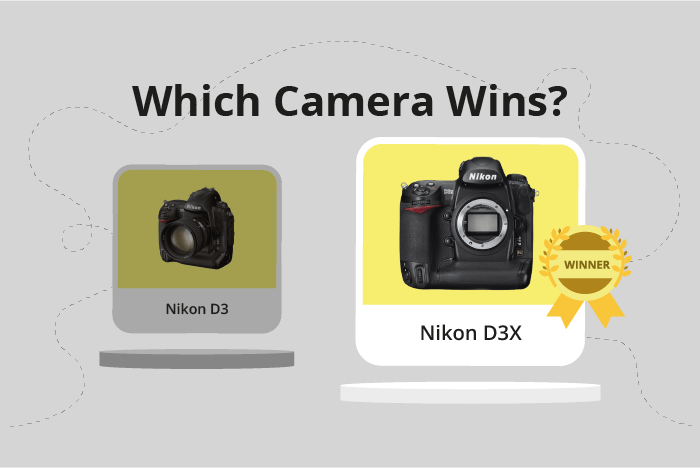Nikon D3 vs D3X Comparison
Nikon D3

Nikon D3X

The Nikon D3X takes the lead with a score of 64/100, while the Nikon D3 follows closely at 58/100. Both DSLR cameras share common specifications, such as their release years (2007 and 2008), camera size (160 x 157 x 88mm), and camera type. However, the Nikon D3X outshines the D3 with its lighter weight of 1260g compared to the D3’s 1300g.
Despite the higher score, the Nikon D3X comes with a heftier launch price of $9,172, while the Nikon D3 is more affordable at $4,300. This price difference may be a deciding factor for some consumers.
Taking into account the specifications and scores, the Nikon D3X offers better performance with a slight advantage in weight. However, the Nikon D3 provides a more budget-friendly option without a significant compromise on quality.
Nikon D3 vs D3X Overview and Optics
The Nikon D3X emerges as the winner in the optics comparison, scoring 65/100, while the Nikon D3 scores 56/100. Both cameras share some common specifications, such as a CMOS sensor, Expeed processor, Full Frame sensor size, Nikon F FX lens mount, and no image stabilization. However, there are differences that contribute to the D3X’s higher score.
The Nikon D3X has a significant advantage in terms of megapixels, boasting 24.5 compared to the D3’s 12.1. This higher resolution allows for more detailed and sharper images, particularly when printing large-sized photos. Additionally, the D3X has a higher DXOMARK score for its sensor, at 88 compared to the D3’s 81. This indicates better overall image quality, including improved dynamic range and color depth.
On the other hand, the Nikon D3 has a faster shooting speed of 11 frames per second, compared to the D3X’s 5 frames per second. This makes the D3 more suitable for capturing fast-moving subjects or action photography, where quick bursts of shots are essential.
In terms of optics, the Nikon D3X is the better choice for photographers seeking higher resolution and image quality. The increased megapixels and superior sensor performance contribute to this advantage. However, the Nikon D3 may still be a suitable option for those who prioritize shooting speed for action photography. Ultimately, the choice between the two cameras will depend on the individual’s specific needs and preferences.
Nikon D3 vs D3X Video Performance
When comparing the Nikon D3 and Nikon D3X, it is important to note that neither camera offers video capabilities. Both the D3 and D3X lack this feature, so there is no difference between them in this aspect.
Nikon D3 vs D3X Features and Benefits
The Nikon D3 and Nikon D3X both have a feature score of 54 out of 100, making them equal in terms of their overall features. They share several specifications, including a 3-inch screen size, the absence of a touchscreen, flip screen, GPS, Wi-Fi, and Bluetooth. The screen resolution is almost identical, with the Nikon D3 having 922,000 dots and the Nikon D3X having 920,000 dots.
Despite their equal scores, the Nikon D3 has a slightly better screen resolution. This difference, though minimal, means that the Nikon D3 provides a marginally clearer and more detailed image on its screen compared to the Nikon D3X.
On the other hand, the Nikon D3X does not offer any specific advantages over the Nikon D3 in terms of features. Both cameras lack modern connectivity options such as Wi-Fi and Bluetooth, as well as other useful features like a touchscreen and flip screen.
In terms of features, the Nikon D3 has a minor edge over the Nikon D3X due to its marginally better screen resolution. However, this difference is minimal and may not be significant enough for most users to prefer one camera over the other. Both cameras are evenly matched, with neither offering a clear advantage in terms of features. Ultimately, potential buyers should consider other factors, such as price, performance, and personal preferences, when deciding between the Nikon D3 and Nikon D3X.
Nikon D3 vs D3X Storage and Battery
The Nikon D3 and Nikon D3X both score 87/100 in storage and battery, indicating a tie in this category. They share common specifications, such as two memory card slots, accepting Compact Flash (Type I or II) cards, and using the EN-EL4a battery type. Neither camera offers USB charging.
However, the Nikon D3X has a slight advantage in battery life, providing 4400 shots compared to the Nikon D3’s 4300 shots. This 100-shot difference may be beneficial for photographers needing extended shooting time. Additionally, the D3X is compatible with UDMA memory cards, offering faster data transfer rates.
On the other hand, there are no specific advantages for the Nikon D3 in storage and battery compared to the D3X. Thus, the D3X proves to be a slightly better option in terms of battery life and memory card compatibility. Both cameras perform well in this category, but the D3X offers a minor edge for users prioritizing extended shooting time and faster data transfers.
Nikon D3 vs D3X – Our Verdict
Are you still undecided about which camera is right for you? Have a look at these popular comparisons that feature the Nikon D3 or the Nikon D3X:

